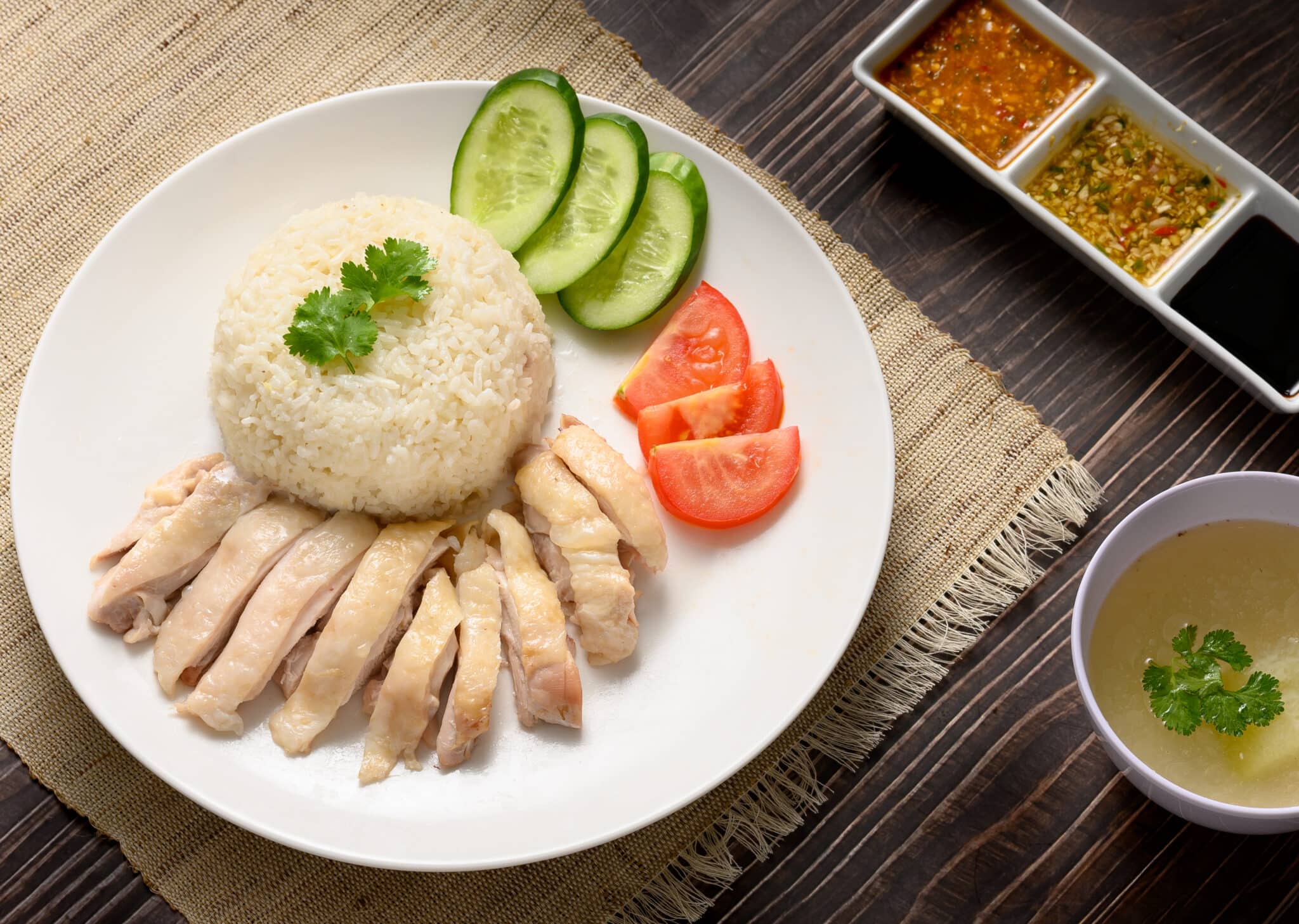
Hainanese Chicken Rice, a dish that has become synonymous with Singapore’s culinary identity, is a simple yet flavorful meal. It’s a comforting combination of tender chicken, fragrant rice, and tangy chili sauce that has won the hearts of locals and tourists alike.
The origins of Hainanese Chicken Rice can be traced back to Hainan province in Southern China. The dish was brought to Singapore by immigrants from Hainan who adapted their traditional recipe to suit local tastes. Over time, it evolved into the version we know today—a testament to Singapore’s multicultural heritage.
Our team at Remitly created this guide as part of our series that celebrates the traditional foods of our global customers.
The Origins of Hainanese Chicken Rice
In its original form in Hainan, the dish was made with Wenchang chicken—a breed known for its lean meat—and served with oily rice. However, as it traveled across borders and cultures, it underwent significant changes.
When the dish arrived in Singapore with the influx of Chinese immigrants during the 19th century, it was adapted using ingredients available locally. This led to the creation of what we now recognize as Singapore’s national dish—Hainanese Chicken Rice.
The Preparation Process: A Closer Look
Preparing Hainanese Chicken Rice involves several steps that require precision and patience. First, the chicken is poached at sub-boiling temperatures until perfectly cooked—tender but not falling apart.
The star of this dish is arguably the rice—it’s cooked in chicken stock along with garlic and ginger which gives it an irresistible aroma and flavor. Finally, a spicy chili sauce made from fresh red chilies, garlic, ginger and lime juice accompanies the dish adding an extra layer of complexity.
While there are variations on how Hainanese Chicken Rice is prepared across different regions or even households in Singapore—the key ingredients remain consistent: chicken, rice and chili sauce.
Recipe for Hainanese Chicken Rice
Creating this iconic dish at home can be a rewarding experience. Here’s a basic recipe to help you get started.
Ingredients
For the chicken:
– 1 whole chicken (about 3-4 lbs)
– Salt
– Ice water
For the rice:
– 2 cups jasmine rice
– 4 cups chicken stock (from poaching the chicken)
– 4 cloves garlic, minced
– 1 thumb-sized piece of ginger, peeled and minced
For the chili sauce:
– 6 fresh red chilies
– 3 cloves garlic
– Same sized ginger as garlic
– Juice of one lime
– Salt to taste
Instructions
Preparing the Chicken:
- Clean the chicken and rub it with salt to exfoliate the skin. Rinse thoroughly.
- Fill a pot with water—enough to cover the chicken—and bring it to a boil.
- Submerge the whole chicken in boiling water, then turn down heat until it’s just below boiling point.
- Poach for about 40 minutes or until fully cooked.
- Once done, plunge the cooked chicken into ice water for a few minutes to stop cooking process and tighten skin.
- Reserve stock for cooking rice and making soup.
Cooking the Rice:
- Rinse jasmine rice under cold water until water runs clear.
- In a pot, sauté minced garlic and ginger until fragrant.
- Add rinsed rice into pot and stir well with garlic and ginger.
- Pour in reserved chicken stock—double amount of rice—and cook on low heat until all liquid is absorbed.
Making Chili Sauce:
- Blend red chilies, garlic, ginger, lime juice, and salt in a food processor until smooth.
Serve your homemade Hainanese Chicken Rice with cucumber slices and garnish with cilantro. Enjoy!
Variations of the Dish
In Singapore, you’ll find several variations of Hainanese Chicken Rice. Some places serve it with roasted chicken instead of poached. Others offer a choice between regular white rice and flavorful chicken rice.
There’s also a version where the chicken is served boneless for those who prefer an easier eating experience. Regardless of these variations, each rendition stays true to its roots—offering comfort in every bite.
How Hainanese Chicken Rice Became Singapore’s National Dish
Hainanese Chicken Rice has been embraced by all communities in Singapore due to its simplicity and versatility. It’s often enjoyed as a daily meal but is also served during special occasions or festive celebrations.
Its popularity grew over time until it became widely acknowledged as Singapore’s national dish—a symbol of the country’s multicultural culinary landscape.
Singapore’s Diverse Cuisine
Singapore’s cuisine is a reflection of its multicultural society, with influences from Chinese, Malay, Indian, and Peranakan cultures.
Chinese Influence
Chinese cuisine in Singapore is diverse, reflecting the different dialect groups. Apart from Hainanese Chicken Rice, other popular dishes include Char Kway Teow (stir-fried rice noodles), Bak Kut Teh (pork rib soup), and Chilli Crab.
Malay Influence
Malay food is known for its bold flavors and use of spices. Famous dishes include Nasi Lemak (coconut milk rice), Satay (grilled meat skewers), and Mee Rebus (noodle dish in sweet potato-based gravy).
Indian Influence
Indian cuisine in Singapore offers a variety of both vegetarian and non-vegetarian dishes. Roti Prata (Indian flatbread), Biryani (spiced rice dish), and Fish Head Curry are among the favorites.
Peranakan Influence
Peranakan or Nyonya cuisine is a unique blend of Chinese ingredients with various distinct spices used by the Malay/Indonesian community. Signature dishes include Laksa (spicy noodle soup) and Ayam Buah Keluak (chicken cooked with Indonesian nuts).
Each culture has contributed to the rich tapestry that makes up Singapore’s culinary scene—making it one of the most vibrant food destinations in the world.
Visit the homepage, download our app, or check out our Help Center to get started.